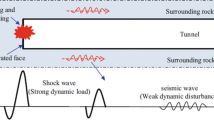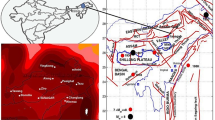Abstract
The seismic performance of gravity dam-reservoir-foundation coupled system is investigated utilizing probabilistic approach. In this research, the uncertainties associated with modeling parameters are incorporated in nonlinear response history simulations to realistically quantify their effects on the seismic performance of the system. The methodology is applied to Pine Flat gravity dam and the foundation is considered to be inhomogeneous assuming a constant spatial geometry but with various rock material properties. The sources of uncertainty are taken into account in the reliability analysis using Latin Hypercube Sampling procedure. The effects of the deconvolution process, number of samples, and foundation inhomogeneity are investigated.
Similar content being viewed by others
References
Bernier C, Padgett J E, Proulx J, Paultre P. Seismic fragility of concrete gravity dams with spatial variation of angle of friction: Case study. Journal of Structural Engineering, 2016, 142(5): 05015002
USACE (US Army Corps of Engineers). Gravity Dam Design. EM-1110-2-2200. 1995
ICOLD (International Commission on Large Dams). Design Features of Dams to Resist Seismic Ground Motion: Guidelines and Case Studies. Bulletin No. 120, 2001
Ellingwood B, Tekie P B. Fragility analysis of concrete gravity dams. Journal of Infrastructure Systems, 2001, 7(2): 41–48
Tekie P B, Ellingwood B. Seismic fragility assessment of concrete gravity dams. Earthquake Engineering & Structural Dynamics, 2003, 32(14): 2221–2240
Lupoi A, Callari C. A probabilistic method for the seismic assessment of existing concrete gravity dams. Structure and Infrastructure Engineering, 2011, 8(10): 985–998
Ghanaat Y, Patev R C, Chudgar A K. Seismic fragility analysis of concrete gravity dams. In: Proceedings of the 15th World Conference on Earthquake Engineering. Tokyo: International Association for Earthquake Engineering, 2012
Alembagheri M, Seyedkazemi M. Seismic performance sensitivity and uncertainty analysis of gravity dams. Earthquake Engineering & Structural Dynamics, 2015, 44(1): 41–58
Liel A B, Haselton C B, Deierlein G G, Baker J W. Incorporating modeling uncertainties in the assessment of seismic collapse risk of buildings. Structural Safety, 2009, 31(2): 197–211
Huang Y, Xiong M. Probability density evolution method for seismic liquefaction performance analysis of earth dam. Earthquake Engineering & Structural Dynamics, 2017, 46(6): 925–943
Altarejos-García L, Escuder-Bueno I, Serrano-Lombillo A, de Membrillera-Ortuño M G. Methodology for estimating the probability of failure by sliding in concrete gravity dams in the context of risk analysis. Structural Safety, 2012, 36–37: 1–13
Fenves G, Chopra A K. Earthquake analysis of concrete gravity dams including reservoir bottom absorption and dam-waterfoundation rock interaction. Earthquake Engineering & Structural Dynamics, 1984, 12(5): 663–680
Alembagheri M, Ghaemian M. Seismic performance evaluation of a jointed arch dam. Structure and Infrastructure Engineering, 2016, 12(2): 256–274
Bieniawski Z T. Engineering Rock Mass Classifications: A Complete Manual for Engineers and Geologists in Mining, Civil, and Petroleum Engineering. Hoboken: John Wiley & Sons, 1989
Vaish A K, Chopra A K. Earthquake finite element analysis of structure-foundation systems. Journal of the Engineering Mechanics Division, 1974, 100(6): 1101–1116
Chopra A K, Chakrabarti P. Earthquake analysis of concrete gravity dams including dam-water-foundation rock interaction. Earthquake Engineering & Structural Dynamics, 1981, 9(4): 363–383
Goodman R E, Powell C. Investigations of blocks in foundations and abutments of concrete dams. Journal of Geotechnical and Geoenvironmental Engineering, 2003, 129(2): 105–116
Chen S H, Qiang S, Shahrour I, Egger P. Composite element analysis of gravity dam on a complicated rock foundation. International Journal of Geomechanics, 2008, 8(5): 275–284
Zhang L, Wang D, Zhang H, Wang W. Stability analysis of gravity dams on sloping layered rock foundation against deep slide. In: Proceedings of the 11th Biennial ASCE Aerospace Division International Conference on Engineering, Science, Construction, and Operations in Challenging Environments. ASCE, 2008
Sanchez-Sesma F J. Site effects on strong ground motion. Soil Dynamics and Earthquake Engineering, 1987, 6(2): 124–132
Léger P, Boughoufalah M. Earthquake input mechanisms for timedomain analysis of dam-foundation systems. Engineering Structures, 1989, 11(1): 37–46
Bayraktar A, Hançer E, Akköse M. Influence of base-rock characteristics on the stochastic dynamic response of dam-reservoir-foundation systems. Engineering Structures, 2005, 27(10): 1498–1508
Deierlein G G. Overview of a comprehensive framework for earthquake performance assessment. In: Fajfar P, Krawinkler H, eds. Performance-Based Seismic Design Concepts and Implementation Proceedings of an International Workshop. Bled: Pacific Earthquake Engineering Research Center, 2004, 15–26
USACE (US Army Corps of Engineers). Time-History Dynamic Analysis of Concrete Hydraulic Structures. EM-1110-2-6051. 2003
Helton J C, Davis F J. Latin hypercube sampling and the propagation of uncertainty in analyses of complex systems. Reliability Engineering & System Safety, 2003, 81(1): 23–69
Rubinstein R Y, Kroese D P. Simulation and the Monte Carlo Method. Vol. 707. Hoboken: John Wiley and Sons, 2011
Dalbey K R, Karystinos G N. Fast generation of space-filling Latin hypercube sample designs. In: Proceedings of the 13th AIAA/ISSMO Multidisciplinary Analysis and Optimization Conference. Fort Worth, 2010
Hamdia K M, Msekh M A, Silani M, Vu-Bac N, Zhuang X, Nguyen-Thoi T, Rabczuk T. Uncertainty quantification of the fracture properties of polymeric nanocomposites based on phase field modeling. Composite Structures, 2015, 133: 1177–1190
Vu-Bac N, Silani M, Lahmer T, Zhuang X, Rabczuk T. A unified framework for stochastic predictions of mechanical properties of polymeric nanocomposites. Computational Materials Science, 2015, 96: 520–535
Reimer R B. Deconvolution of seismic response for linear systems. University of California at Berkeley Report CB/EERC-73/10. 1973
Ghanaat Y, Hashimoto P S, Zuchat O, Kennedy R P. Seismic fragility of Muhleberg dam using nonlinear analysis with Latin Hypercube simulation. In: Proceedings of the 31st Annual USSD Conference. San Diego, 2011, 1197–1212
Saouma V, Hansen E, Rajagopalan B. Statistical and 3D nonlinear finite element analysis of Schlegeis dam. In: Proceedings of the Sixth ICOLD Benchmark Workshop on Numerical Analysis of Dams. 2001, 17–19
Cvijanovic V, Schultz M G. Nonlinear finite element model validation at lower crystal springs dam and Pacoima dam. Journal of Dam Safety, ASDSO, 2016, 14(1): 33–37
Sooch G S, Bagchi A. A new iterative procedure for deconvolution of seismic ground motion in dam-reservoir-foundation systems. Journal of Applied Mathematics, 2014, 287605
Bretas E M, Lemos J V, Lourenço P B. Seismic analysis of masonry gravity dams using the discrete element method: Implementation and application. Journal of Earthquake Engineering, 2016, 20(2): 157–184
USBR (United States Bureau of Reclamation). State-of-practice for the nonlinear analysis of concrete dams at the Bureau of Reclamation. 2013
Haukaas T, Der Kiureghian A. Finite element reliability and sensitivity methods for performance-based earthquake engineering. Peer, 2004, 266
USBR (United States Bureau of Reclamation). Upper San Joaquin River Basin Storage Investigation, Raise Pine Flat Dam. Surface Storage Option Technical Appendix to the Phase 1 Investigation Report. 2003
Alembagheri M, Estekanchi H E. Nonlinear analysis of aboveground anchored steel tanks using endurance time method. Asian Journal of Civil Engineering, 2011, 12(6): 731–750
Alembagheri M. Dynamics of submerged intake towers including interaction with dam and foundation. Soil Dynamics and Earthquake Engineering, 2016, 84: 108–119
Alembagheri M, Ghaemian M. Incremental dynamic analysis of concrete gravity dams including base and lift joints. Earthquake Engineering and Engineering Vibration, 2013, 12(1): 119–134
Ghanaat Y. Failure modes approach to safety evaluation of dams. In: Proceedings of the 13th World Conference on Earthquake Engineering. Vancouver, 2004, 1115
Hamdia K M, Silani M, Zhuang X, He P, Rabczuk T. Stochastic analysis of the fracture toughness of polymeric nanoparticle composites using polynomial chaos expansions. International Journal of Fracture, 2017, 206(2): 215–227
Lo K Y, Lukajic B, Wang S, Ogawa T, Tsui K K. Evaluation of strength parameters of concrete-rock interface for dam safety assessment. In: Proceedings of Canadian Dam Safety Conference. Toronto, 1990, 71–94
EPRI (Electrical Power Research Institute). Uplift Pressures, Shear Strengths, and Tensile Strengths for Stability Analysis of Concrete Gravity Dams. EPRI TR-100345. 1992
Champagne K, Rivard P, Quirion M. Shear strength parameters of concrete gravity dams in Quebec. In: Proceedings of CDA 2013 Annual Conference. Toronto, 2012
Lin G, Du J, Hu Z. Earthquake analysis of arch and gravity dams including the effects of foundation inhomogeneity. Frontiers of Architecture and Civil Engineering in China, 2007, 1(1): 41–50
Melchers R E. Structural Reliability Analysis and Prediction. New York: John Wiley & Son, 1999
Iman R L. Encyclopedia of quantitative risk analysis and assessment. New York: John Wiley & Son, 2008
Broding W C, Diederich F W, Parker P S. Structural optimization and design based on a reliability design criterion. Journal of Spacecraft and Rockets, 1964, 1(1): 56–61
Chauhan S S, Bowles D S. Dam safety risk assessment with uncertainty analysis. Ancold Bulletin, 2004, 73–88
Anderson TW, Darling D A. A test of goodness of fit. Journal of the American Statistical Association, 1954, 49(268): 765–769
Vu-Bac N, Lahmer T, Zhang Y, Zhuang X, Rabczuk T. Stochastic predictions of interfacial characteristic of polymeric nanocomposites (PNCs). Composites. Part B, Engineering, 2014, 59: 80–95
Vu-Bac N, Lahmer T, Zhuang X, Nguyen-Thoi T, Rabczuk T. A software framework for probabilistic sensitivity analysis for computationally expensive models. Advances in Engineering Software, 2016, 100: 19–31
Harris D W, Mohorovic C E, Dolen T P. Dynamic properties of mass concrete obtained from dam cores. Materials Journal, 2000, 97(3): 290–296
Fenves G L, Chavez J W. Evaluation of earthquake induced sliding in gravity dams. In: Proceedings of the 11th World Conference on Earthquake Engineering. Tokyo, 1996
USBR (United States Bureau of Reclamation). Guidelines for Achieving Public Protection in Dam Safety Decision Making. Technical Report. 2003
Munger D F, Bowles D S, Boyer D D, Davis D W, Margo D A, Moser D A, Regan P J, Snortel N. Interim tolerable risk guidelines for US Army Corps of Engineers dams. In: Proceedings of the 29th Annual United States Society on Dams Conference. 2009, 1125–1141
Vanmarcke E H. Matrix formulation of reliability analysis and reliability-based design. Computers & Structures, 1973, 3(4): 757–770
Karamchandani A, Cornell C A. Sensitivity estimation within first and second order reliability methods. Structural Safety, 1992, 11(2): 95–107
Liping W, Grandhi R V. Efficient safety index calculation for structural reliability analysis. Computers & Structures, 1994, 52(1): 103–111
Author information
Authors and Affiliations
Corresponding author
Rights and permissions
About this article
Cite this article
Ganji, H.T., Alembagheri, M. & Khaneghahi, M.H. Evaluation of seismic reliability of gravity dam-reservoirinhomogeneous foundation coupled system. Front. Struct. Civ. Eng. 13, 701–715 (2019). https://doi.org/10.1007/s11709-018-0507-1
Received:
Accepted:
Published:
Issue Date:
DOI: https://doi.org/10.1007/s11709-018-0507-1




